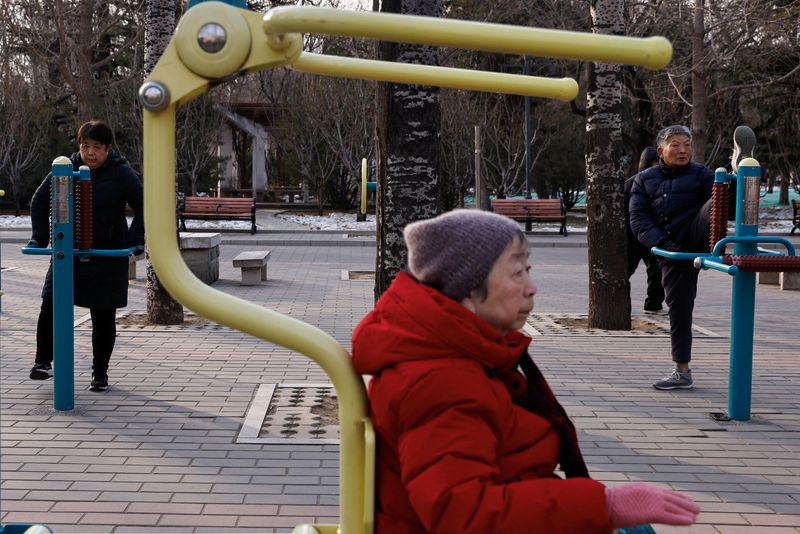By Jamie McGeever
ORLANDO, Florida (Reuters) - The latest readouts on economic and population trends in China are remarkable, highlighting the immense long-term challenges ahead and dragging the growth profile of the world's second-largest economy back to the insular days of the 1970s.
Excluding the pandemic shock of 2020, nominal Chinese GDP growth slowed last year to its lowest since Mao Zedong led the country in the mid-1970s, according to some estimates.
Official figures also showed China's population fell for a second consecutive year, and more than twice as fast as the decline in 2022, which was the first since 1961 during the Great Famine.
While there is a case to make that the gloom among global investors towards China is excessive, one of the lowest nominal GDP growth rates and the fastest population decline in decades are powerful counterpoints.
Analysts at Deutsche Bank estimate that nominal GDP growth last year was just 4.2%. Putting 2020 aside, this would be the lowest annual nominal growth since 1976, the year Mao died.
Of course, China's economy today is unrecognizable from the mid-1970s in its makeup, size and importance to the global economy. But this is a marker.
Calculating nominal growth is an inexact science as it depends on the "deflator" used. GDP growth is usually measured in inflation-adjusted terms, so a nominal reading requires a measure of inflation to be added back on.
Or in the case of China now, a deflation rate to be subtracted.
Official population figures, meanwhile, show that the birth rate in China fell to a record low last year, and the population declined by 2.08 million, or 0.15%, to 1.409 billion.
There's no immediate or clear connection between last year's nominal growth rate and the more glacial population shift. But many investors - overseas and domestic - will see them both as reasons to be cautious on China Inc.
Deutsche Bank's Jim Reid wonders whether a "new normal" nominal GDP landscape for China is being established.
He notes that nominal GDP grew at an annual average of 15.5% in the 1980s, increasing to 18.5% in the 1990s, easing to 14.5% in the 2000s, and slowing further to 11.0% in the 2010s. The current decade is on course to average 6.2% by the end of this year.
"A big change for China and for the world," Reid wrote on Wednesday.
STOCKS SINK
Other estimates of nominal GDP growth are slightly higher, but paint a similar picture. Economists at Societe Generale (OTC:SCGLY), for example, estimate it slowed to 4.6% last year.
The political optics are intriguing too. Full-year figures for the U.S. and Japan have yet to be published, but it is likely that China's nominal growth last year was lower than both of its key economic adversaries.
Organisation for Economic Co-operation and Development (OECD) estimates suggest China's nominal GDP growth last year was lower than Japan's for the first time in at least 30 years at 5.2% versus 5.3%.
Nominal growth rates are cited less because they do not take into account inflation or deflation. But they still matter - governments, businesses, economists and investors use them to set and measure budgets, tax revenues, wage agreements, debt ratios, earnings and other key financial metrics.
From a growth perspective, meanwhile, a shrinking population is a major headache for policymakers. It means there are fewer people producing goods and services, fewer people demanding those goods and services, and fewer people contributing the tax revenues Beijing needs to support an ageing population.
In that light, it's little wonder investors are cooling on China, pulling their money out, and questioning whether to return.
Chinese stocks have sunk to a five-year low, and have lagged their global peers for years. Take the last three years - the S&P 500 and Japan's Nikkei are both up about 25%, the MSCI World is up nearly 10%, and China's CSI 300 is down 40%.
It's also little wonder that Chinese Premier Li Qiang has been on a global charm offensive recently, including a lunch in Davos with U.S. financial titans Jamie Dimon, Steve Schwarzman and others to convince the world that China is open for business.
Even before the politics are considered, it may not have been an easy sell.
A Reuters poll of economists points to real GDP growth of 4.6% this year and CPI inflation of 1.0%. But if deflationary pressures persist - producer prices have been falling year-on-year since October 2022 - nominal GDP growth could yet shrink further.
Barclays economists are below consensus with a 4.4% call, yet wrote this week: "Risks to our below-consensus forecast also remain tilted to the downside."
(The opinions expressed here are those of the author, a columnist for Reuters.)
(By Jamie McGeever; Editing by Jamie Freed)
